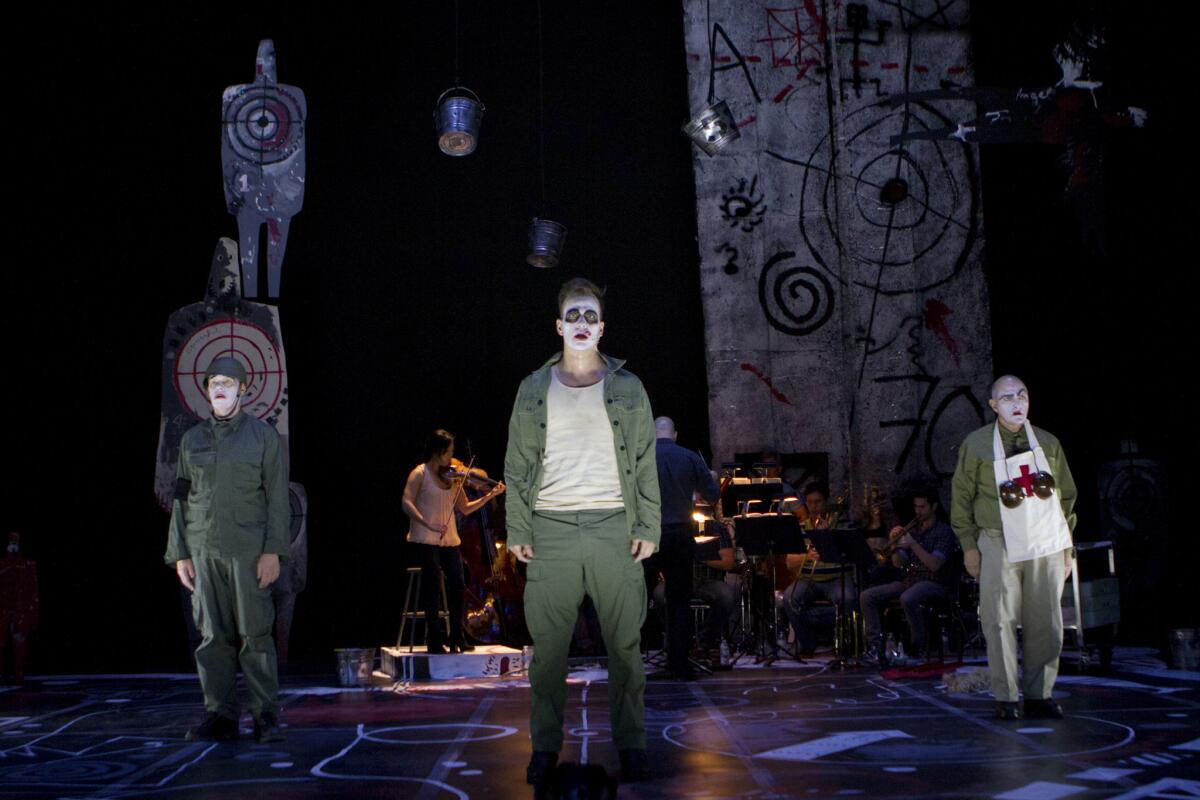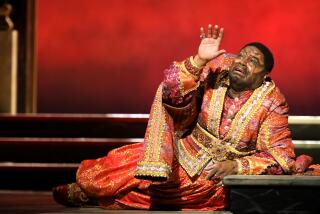Review: Long Beach Opera stretches Stravinsky with two makeovers

A complete art form, opera can select from a list of ingredients that includes music, text, theater, visual art, dance, film and, lately, virtual reality and even brain waves. Smell, taste and touch have been experimented with in extreme cases. Recipes vary as to what and how much.
In his final opera, “Capriccio,” Richard Strauss debated the primacy of words or music. He had a narrow view of opera.
Long Beach Opera has a wider view. Sunday night at Terrace Theater it mounted productions of two different versions of Stravinsky’s “L’Histoire du Soldat” (A Soldier’s Tale). Neither work is Stravinsky’s “Histoire.” Nor are “An American Soldier’s Tale” and “A Fiddler’s Tale” operas, if you insist that opera must be written for singers.
Written in 1918, in the wake of the Russian Revolution and during World War I, the original “Histoire” is the story of a soldier on leave who trades his violin to the devil for riches. Stravinsky’s intentions were not operatic. He wanted a modern minstrel show that could travel with a portable stage, three actors — narrator, soldier and devil — and seven musicians. He needed money.
Stravinsky’s score, with its off-kilter march and popular dances and sour chorale, has proved one of his most popular. But C.F. Ramuz’s doggerel French text is the weak link.
“No one who loves the ‘Histoire’ pays the story much attention,” Stravinsky scholar Richard Taruskin has written. Kurt Vonnegut called it “a piece of crap.” LBO obviously agrees. It needs money too. Sunday’s audience was urged to help fill a $150,000 shortfall by June 30.
“An American Soldier’s Tale” is Vonnegut’s response to once having been asked to be the narrator of a performance of “Histoire.” He refused, finding Ramuz’s application of fanciful Russian folk literature to the horrors of a lovelorn soldier’s lot to be ridiculous. Later, on a challenge from George Plimpton, Vonnegut wrote his own text to go along with Stravinsky’s score.
Wynton Marsalis’ “A Fiddler’s Tale,” meant as a companion piece to “Histoire,” includes new music that riffs respectfully on Stravinsky and a text by Stanley Crouch that riffs rowdily on Ramuz. With madcap interrelated productions by David Schweizer, LBO appears to be the first company to stage these two “Histoire” makeovers and to combine them on a double bill.
Vonnegut’s tale is based on the case of Private Eddie D. Slovik, who happened to be the epitome of the hapless soldier. Out of thousands of American soldiers who have deserted since the Civil War, Slovik is the only one executed. He was killed by firing squad in front of his comrades in 1945. Dwight D. Eisenhower signed the order, offering the private from Chicago the choice of rejoining his company and receiving an honorable discharge after the war or death. Slovik didn’t want to carry a gun and saw no choice, so he took the quick way out.
Vonnegut’s text is, not surprisingly, sardonic. With a backdrop of cutout soldier targets by set designer Danila Korogodsky, Schweizer treats Slovik, a general (who also serves as a narrator) and a military policeman as clownish, slapstick characters. Vonnegut does away with the love interest in Ramuz’s text — in “Histoire” the soldier takes up with a princess — but he does supply a Red Cross nurse, who in this production is played in drag by the policeman. It gives Vonnegut the chance to rhyme Red Cross with dental floss. “West Point was my joint” is another great Vonnegut rhyme.
There may not be a devil in “An American Soldier’s Tale,” but Slovik, a sad sack from Chicago who had once been jailed for petty theft, is damned by being drafted. As played by Kevin Reich, Slovik is a punching bag for the general (Tony Abatemarco) as well as the policeman and nurse (Mark Bringelson). All seem like puppets on strings, these cavorting, wise cracking, falling-down goofy clowns. Is the devil their master? Or Ike?
Or Stravinsky? The ensemble, conducted by Kristof Van Grysperre, may have played on the straightforward side, but Alyssa Park’s violin solos were gripping. Vonnegut’s great invention, elaborately underscored by Schweizer, is to bring out the nasty undertone so that in every bar you realize that the devil is in the details.
Marsalis uses the same ensemble of violin, bassoon, clarinet, trumpet, trombone, bass and percussion as Stravinsky and has the same musical structure. But if Stravinsky is the DNA of “A Fiddler’s Tale,” Marsalis’ musical style, swinging between abstract post-Stravinskian chamber music and jazz, is Marsalis’ own jazz style. At the premiere in 1998, Marsalis was the trumpet solo with members of the Chamber Music Society of Lincoln Center.
Meanwhile, Crouch’s text for a narrator takes over. This becomes the story of Bubba Z. Beals, or BZB, a record producer who seduces a violinist named Beatrice and makes her a star. But just as riches sap the soul of Ramuz’s soldier, Beatrice finds fame, when it’s the devil’s doing, the enemy of art.
Crouch is far wordier and weirder than Ramuz, and Schweizer and actor Roger Guenveur Smith turn “Fiddler’s Tale” into something spectacularly over-the-top. Smith’s drawling jive devilry can be insufferably obnoxious, and it takes a while to warm to his show-off, Brando-esque style of bedeviling.
But once Smith hits his stride, Marsalis’ score can barely keep up with him. When Marsalis is smooth, Smith is smoother. When the score is rowdy, Smith is the exuberantly exaggerated devil incarnate, as well as the voice of the put-upon violinist Beatrice and huckster Uncle Bud.
Marsalis features the violin as much, if not more, than Stravinsky does. Despite rushing from performing in a new music festival in Venice to Long Beach on Sunday, Park remained unceasingly glamorous throughout. And the band cooked with needed.
But the musicians here are ultimately accessories to Smith, just as the orchestra in a bel canto opera is to a star coloratura. An exorbitantly physical performer, the actor growls and groans, croons and murmurs, raps and wails so musically that he simply extends the definition of singing. And of opera.
---------------------------
‘An American Soldier’s Tale’ and ‘A Fiddler’s Tale’
Where: Long Beach Opera, Terrace Theater, 300 Ocean Blvd., Long Beach
When: 2 p.m. Sat.
Cost: $29-$160
Contact: (562) 432-5934 or https://www.longbeachopera.org
Running time: 2 hours, 25 minutes
More to Read
The biggest entertainment stories
Get our big stories about Hollywood, film, television, music, arts, culture and more right in your inbox as soon as they publish.
You may occasionally receive promotional content from the Los Angeles Times.







